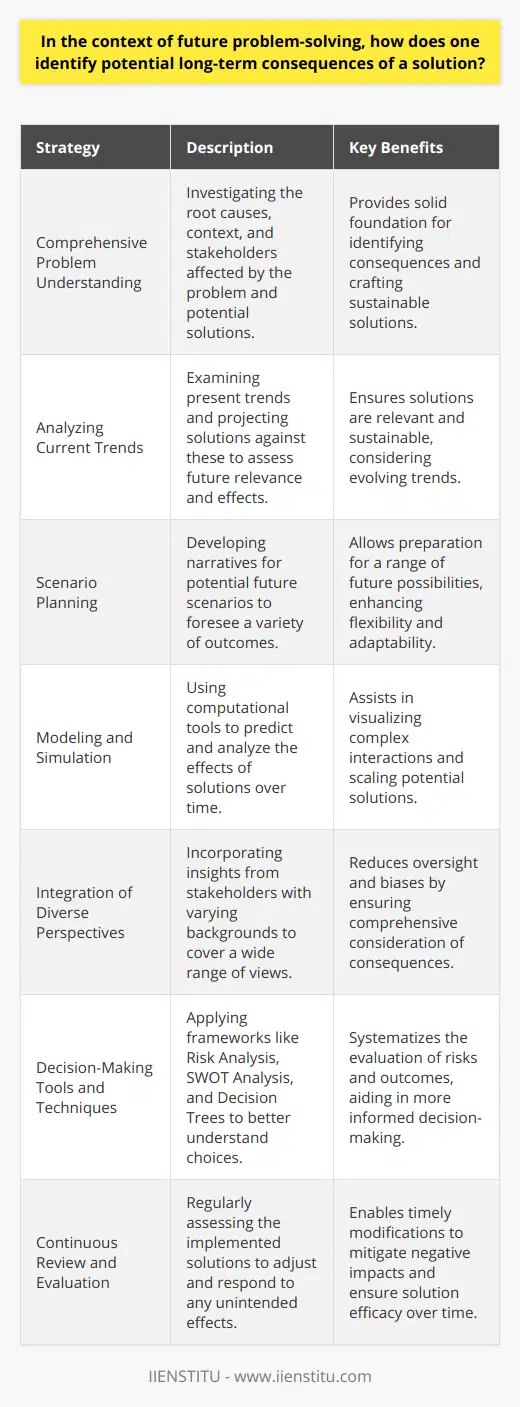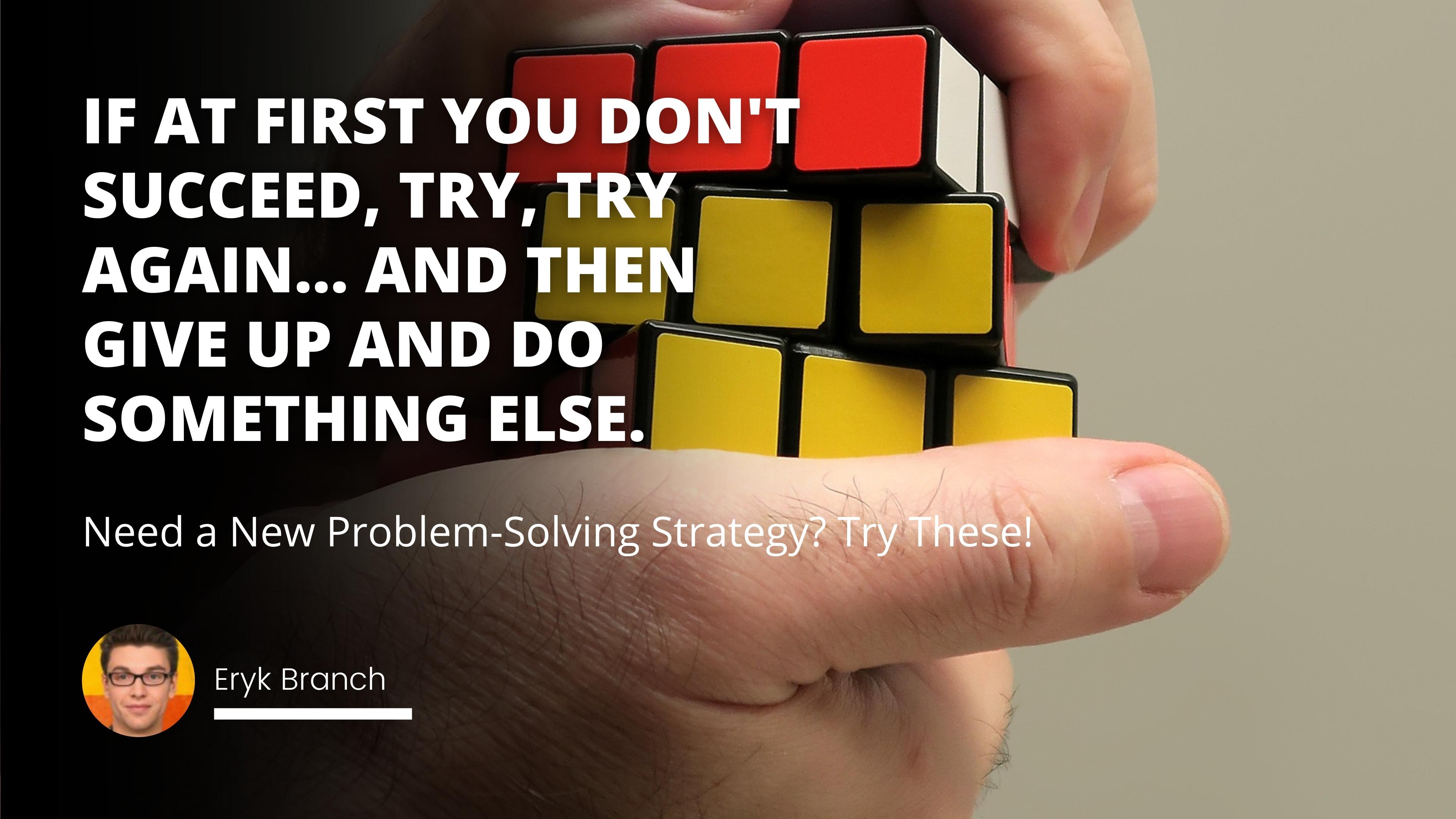
At its core, problem-solving is simply the process of identifying and addressing a challenge or obstacle that stands in the way of achieving a goal. While many different strategies and techniques can be used to solve problems effectively, three key steps are essential for any successful problem-solving process: gathering information, developing possible solutions, and evaluating potential solutions.
Whether you are facing a workplace challenge, tackling a personal problem, or working to overcome a difficult obstacle, the key to success is assessing the situation thoroughly, gathering all of the necessary information, and carefully evaluate your options.
This may involve brainstorming potential solutions with colleagues or seeking input from experts, as well as carefully considering the possible outcomes of each option. Ultimately, the key is to be persistent and remain focused on finding a solution that works for you. With the right mindset and approach, any problem can be successfully solved.
Are you tired of wasting time on problems that you can't solve? This guide will systematically show you how to solve any problem in just three steps.
Whether you are facing a work challenge, tackling a personal problem, or struggling to overcome an obstacle, the key to success has the right mindset and approach to problem-solving. At its core, problem-solving involves:
Identifying the challenge or obstacle that stands in your way.
Gathering information to understand the situation entirely.
Considering all of your possible solutions before deciding on the best course of action.
To solve a problem, you need to be able to gather enough and the right kind of information.
To successfully solve a problem, you must have accurate information about that problem. This involves being able to gather the right kind of data, as well as having the knowledge and skills needed to interpret it effectively. One essential part of problem-solving is analyzing the problem, which requires you to break it down into smaller components to understand its root causes better.
Once you have gathered enough data and understand the problem, you can begin considering possible solutions and selecting the best ones based on your available resources. Ultimately, analyzing a problem and gathering relevant information is crucial for achieving effective problem-solving results.
Developing possible solutions is an essential step in the problem-solving process steps.
Once you clearly understand the problem, your next step is to start thinking creatively about possible solutions. This may involve brainstorming ideas with colleagues or seeking input from experts, as well as considering potential outcomes for each option and weighing the pros and cons of each solution before making a final decision.
In many cases, trying out different solutions to see what works best can also be helpful. Then, with persistence, focus, and creativity, you can develop practical solutions that will allow you to overcome any challenge or obstacle that stands in your way.
Evaluating potential solutions is key to ensuring that you choose the right approach to solve your problem.
Before making a final decision about the best course of action, it is essential to evaluate your potential solutions and consider the possible outcomes carefully. This may involve conducting research, consulting with subject matter experts, or running tests to determine which solution will most effectively address your challenge or obstacle. It is also essential to consider any risks associated with each option and how feasible it will be to implement the chosen solution based on your available resources.
With a clear understanding of the problem, the right mindset and approach for problem-solving, and a willingness to explore different options, you can successfully overcome any challenge or obstacle that stands in your way. In addition, adopting these essential problem-solving skills will enable you to achieve your goals and live a more fulfilling and successful life at work or in your personal life.
Don't let problems hold you back any longer. With this simple three-step process, you will be able to quickly and effectively solve any problem that comes your way. The first step is gathering enough information about the issue at hand. Once you have a good understanding of what the problem is, you can begin developing possible solutions.
After narrowing down your options, it's essential to evaluate each potential solution to ensure that you choose the best option for solving your problem. Join our course on problem-solving today and learn how to overcome any obstacle life throws your way.
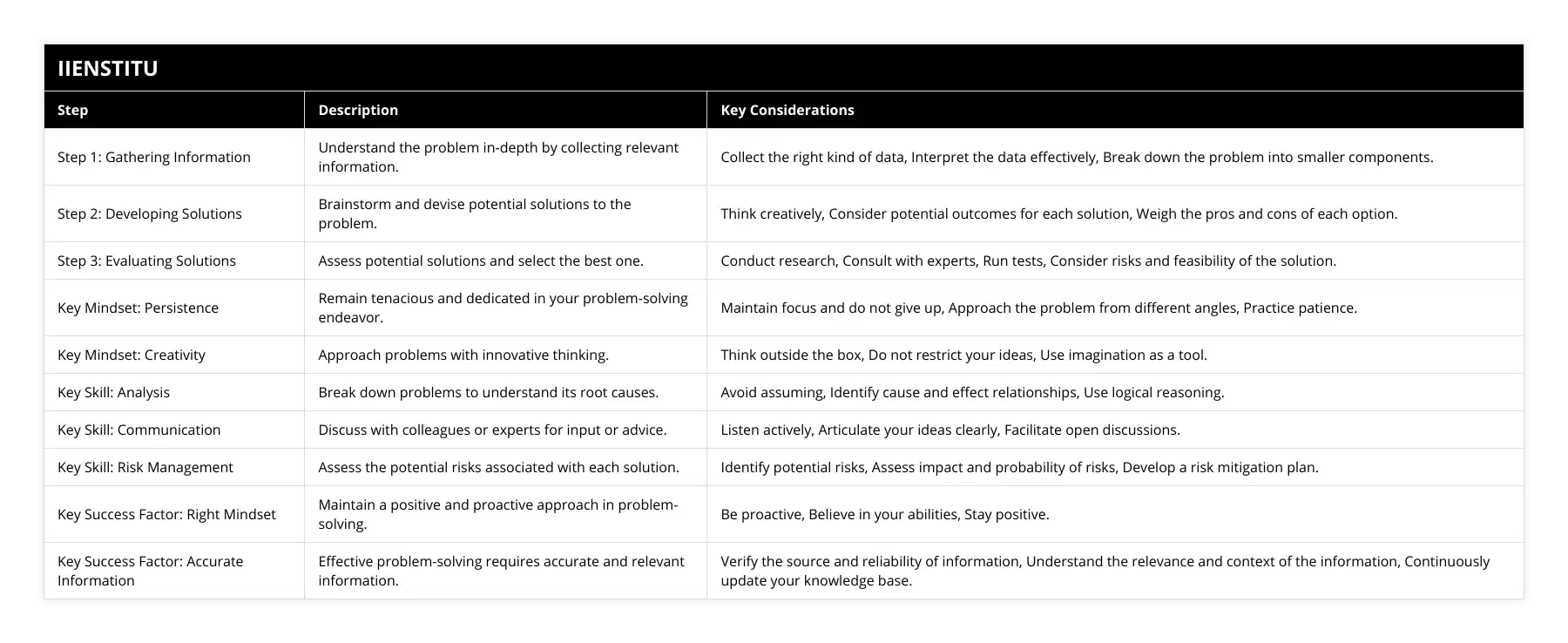
Frequently Asked Questions
What's your favorite problem-solving technique?
My favorite problem-solving technique is breaking down the problem into smaller parts and then attacking each piece individually. This involves understanding the problem, devising a plan of action, implementing the program, and checking to ensure the solution solves the problem.
This technique works well because it helps you focus on one task at a time and prevents you from getting overwhelmed by the size or complexity of the problem. It also allows you to test different solutions and see which works best. And finally, it helps you ensure that your solution solves the problem.
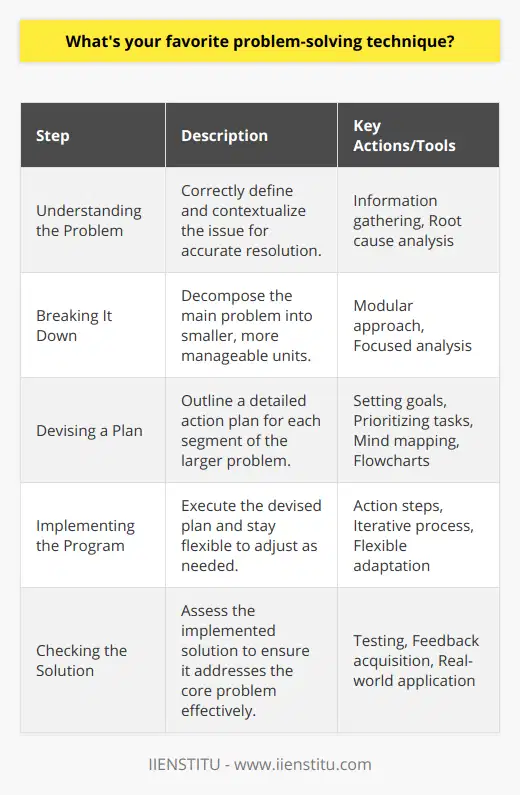
Do you prefer to work on problems alone or with others?
I prefer to work on problems with others. I think it's essential to have different perspectives when solving problems. Everyone has strengths and weaknesses, so it's helpful to have as many different viewpoints as possible when trying to solve a problem. Plus, working with others can be a lot of fun!
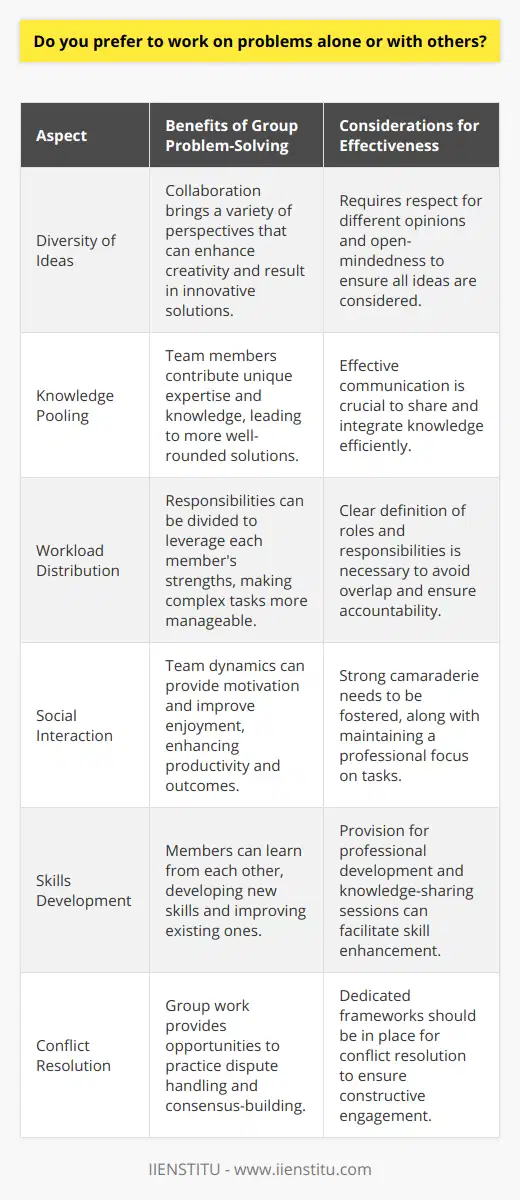
Have you ever had a problem that you couldn't solve? If so, how did you go about finding a solution?
I have had a problem that I couldn't solve. If so, how did you go about it?
First, I would try to narrow the problem as much as possible. Then, I would research the problem and try to find any potential solutions. After that, I would test those potential solutions to see if they worked.
If none of the possible solutions worked, I would start from scratch and develop a new plan of action. Finally, I would execute that plan of action and hope for the best.
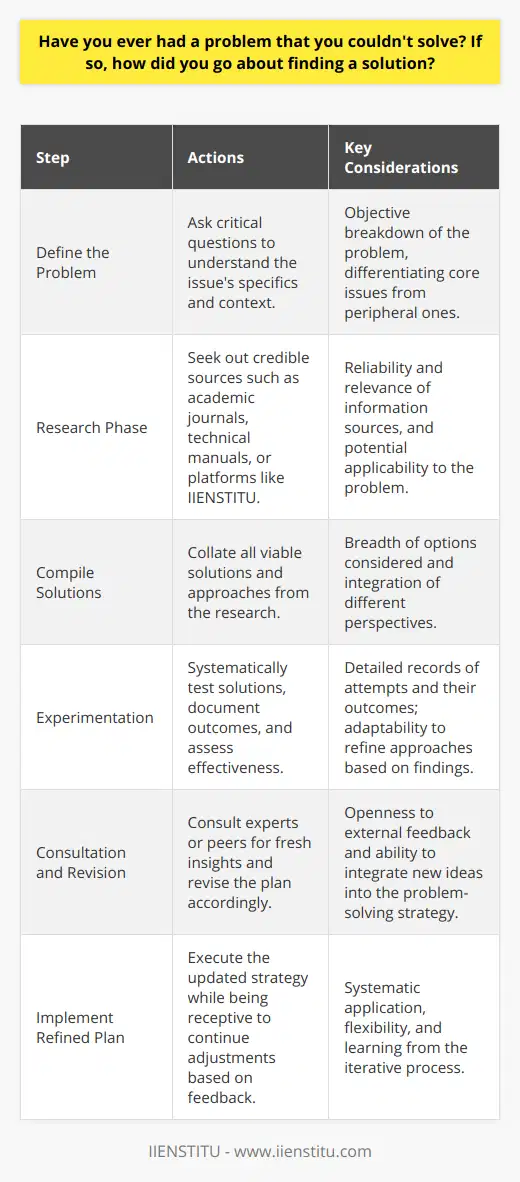
Is there a problem-solving method that you're particularly interested in but haven't had the opportunity to try yet?
I'm interested in the problem-solving process itself. The problem-solving process entails breaking a problem into smaller and smaller manageable parts. Then, once the smaller pieces are understood, the solution to the original problem can be found.
This approach is often called "Divide and Conquer." And it's a very effective way of solving problems. The key is to break the problem into manageable chunks and take one step at a time.
Of course, if you try to solve the entire problem simultaneously, you will likely become overwhelmed and frustrated. But taking it one step at a time can slowly but surely work toward a solution.
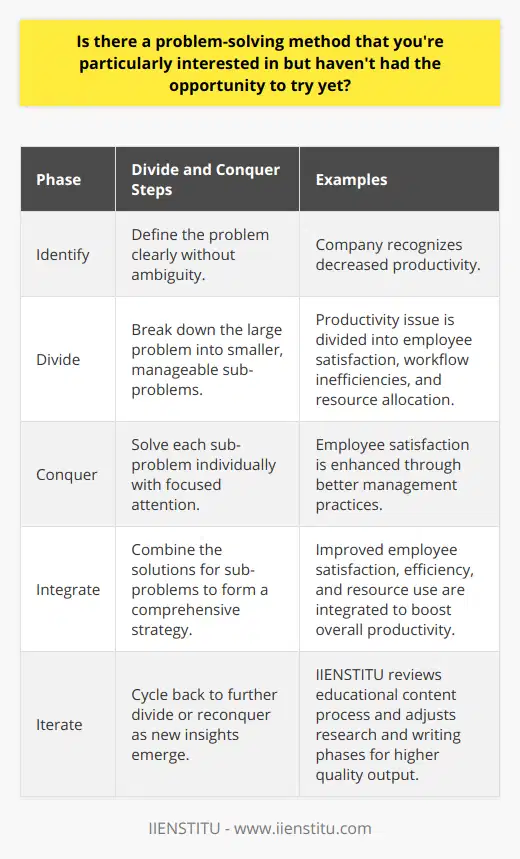
Do you think there's always a solution to every problem, or are some problems unsolvable?
There is never a simple solution to every problem. Many problems don't have a definitive answer. What is important is how we approach problem-solving.
The first step in any problem-solving process is to identify the problem. This cannot be easy because sometimes we are so close to a situation that we can't see it objectively. However, once the issue is identified, we can look for potential solutions.
Not all solutions are viable, and some may even worsen; therefore, it is a problem. It's essential to evaluate all potential solutions and choose the best one. Sometimes this means trying multiple solutions until one works.
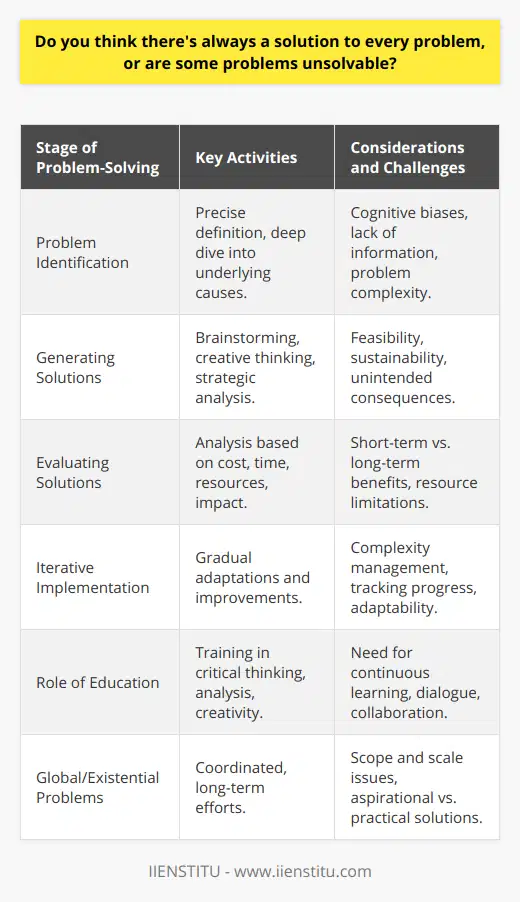
Are there any tricks or tactics to help you solve problems more efficiently?
There's no one-size-fits-all answer to this question, as the best way to solve problems will vary depending on the situation. However, a general process that can be useful for solving many types of issues is illustrated in the diagram below.
The first step is to identify and understand the problem. This may involve identifying the problem's root cause and understanding all the relevant facts and figures. Once you have a good understanding of the problem, you can then begin brainstorming possible solutions. After you have a few potential solutions, evaluating them carefully and selecting the best one is essential.

What are the three main steps of problem-solving?
Solving Problems Step-by-Step
The initial phase in problem-solving involves Identifying and Understanding the Problem. This crucial starting point requires to clearly defining the issue. This step necessitates a thorough analysis of what the actual problem is, its contextual elements, and its potential implications.
Following the identification is the Developing Possible Solutions stage. You need to brainstorm various strategies to handle the identified problem in this second step. The emphasis here is on generating a wide array of potential solutions. These strategies must be carefully assessed and selected in order to come up with the most effective solution.
After you have identified potential solutions, the final step is Implementing the Chosen Solution. This phase requires action. A decision needs to be made on which solution or combination of solutions will be executed. After that, you must follow through by initiating efforts that will lead to the resolution of the problem.
In conclusion, the three main steps of problem-solving include Identifying and Understanding the Problem, Developing Possible Solutions, and Implementing the Chosen Solution. These steps equip individuals with the necessary methodologies to navigate through any issue in a systematic and logical manner.
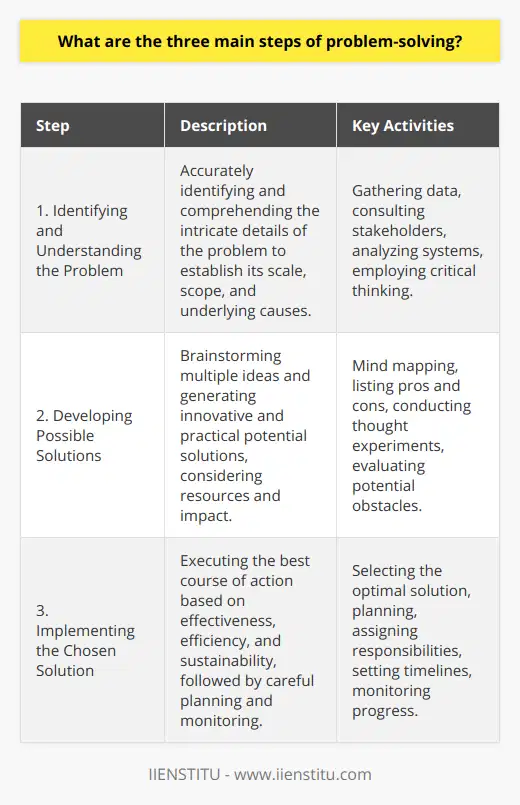
How does future problem-solving differ from traditional problem-solving approaches?
Proactive Approach of Future Problem-Solving
Traditional problem-solving methods mainly focus on resolving issues as they arise. This involves identifying a problem, determining its cause, examining potential strategies, implementing a solution, and assessing its effectiveness. They are more reactive in nature, tackling problems that have already occurred.
On the contrary, future problem-solving is more about anticipation. Instead of waiting for problems to occur, it assumes probable issues to arise in the future. It then engages in creating strategies to prevent those problems or mitigate their impact. This proactive approach of preemptively addressing potential problems is a key characteristic of future problem-solving.
Use of Foresight in Future Problem-Solving
In addition to anticipating problems, future problem-solving often uses foresight techniques, such as forecasting or scenario planning. These methods enable a better understanding of potential future environments and how current decisions might impact them. Hence, future problem-solving is not only about solving problems but also about crafting the future.
Systems Thinking in Future Problem-Solving
Another aspect that sets future problem-solving apart is the use of systems thinking. Instead of looking at problems in isolation, it sees them as part of a larger system. This approach helps in grasping the big picture and understanding the complex interdependence between various elements.
In conclusion, future problem-solving surpasses traditional problem-solving just from being reactive to proactive. It is not only about dealing with present realities but also preparing for prospective issues. It leverages foresight tools and systems thinking to understand and shape the future, making it a more comprehensive and strategic approach to problem-solving.
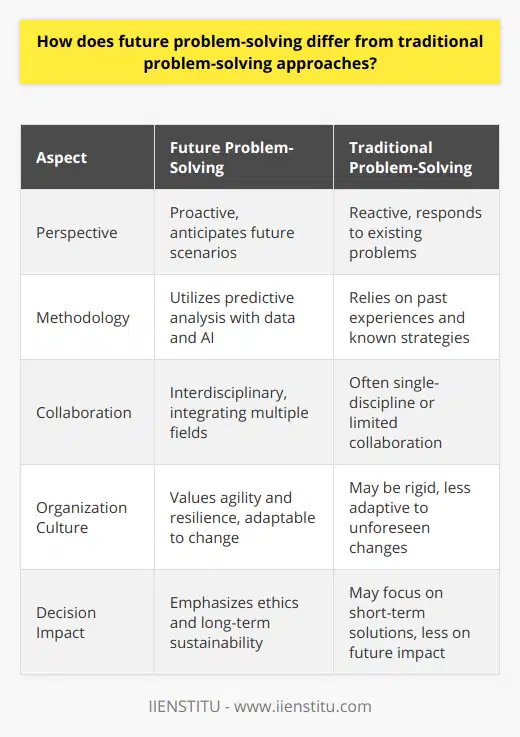
In the context of future problem-solving, how does one identify potential long-term consequences of a solution?
Identification of Potential Long-Term Consequences
In foreseeing the long-term outcomes of a solution, certain strategies can be observed. First and foremost, one must understand the problem comprehensively. By doing so, they position themselves to anticipate the impacts of the solution better.
Analyzing Current Trends
Analyzing trends associated with the problem helps to predict potential challenges. It involves looking at current patterns within the system and using them to envisage probable impacts.
Implementing Scenario Planning
Scenario planning avails one with multiple hypothetical situations, giving an array of potential outcomes. It allows decision-makers to examine a diverse range of scenarios and anticipate possible effects.
Modeling and Simulation
Additionally, the use of modeling and simulation is essential. These tactics offer a visual representation of the likely consequences, making it easier to discern long-term effects.
Integration of Diverse Perspectives
Involving a diverse group of stakeholders is also helpful. They provide unique insights into potential outcomes, assisting one to perceive the long-term consequences from a more holistic approach.
Use of Decision-Making Tools and Techniques
Further, one can employ various decision-making tools and techniques. Techniques such as Risk Analysis, SWOT Analysis, and Decision Trees help in predicting long-term consequences, highlighting potential risks and benefits.
Continuous Review and Evaluation
Finally, a continuous review and evaluation process allows for early identification of the long-term implications. Regular assessments help in detecting unforeseen consequences, aiding in corrective measures.
True tailoring of future problem-solving demands imaginative and strategic thinking. Taking steps to identify long-term consequences, as discussed above, is central in developing sustainable solutions. Utilizing these strategies promotes robust, adaptable problem-solving, instrumental in navigating the ever-evolving complexities of the future.
